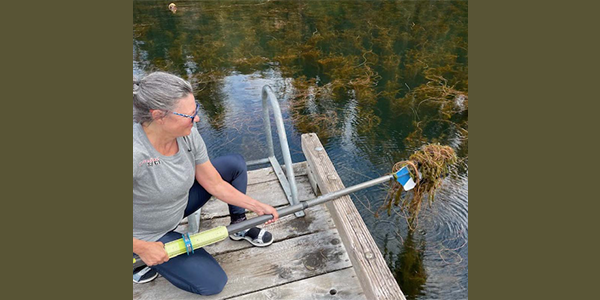||| FROM TOBY COOPER for THE SALISH CURRENT |||
Eurasian watermilfoil — a fast-growing, non-native aquatic plant that threatens the natural freshwater ecosystems, human recreation and domestic water infrastructure — has infested Orcas Island’s Cascade Lake, prompting the Washington State Parks authority to seek permits for control.
The popular lake in Moran State Park doubles as the domestic water source for hundreds of households in Orcas Island’s Rosario district and the destination of choice for many of the park’s 900,000 yearly visitors. Unchecked milfoil threatens both, and the park’s administrators must decide how to protect the habitat.
Water administrators in Washington have a standing permit that allows them to assess and authorize control measures for invasive aquatic plants, explained Shawn Ultican, the designated permit officer at the Washington State Department of Ecology who is handling the park’s application.
Under that umbrella authorization established by the federal Clean Water Act and the Water Pollution Control Act, Moran has been granted a coverage permit as of July 1. It gives Moran State Park an immediate war chest — up to $75,000 in a matching grant account — with which to design a specific battle plan against Cascade Lake’s invasive milfoil.
Moran State Park takes the lead
Lizbeth Seebacher, Northwest Region Steward for Washington State Parks, is charged with managing the mitigation program. “I am leading the way,” she said, and she and Wes Glisson of the Washington Department of Ecology found Eurasian watermilfoil in lake the last summer.
The 2023 biological survey — the first in the park since 1997 — sought data on heavy metal contamination in fish. Instead, they found milfoil. Seebacher knew they had to act. “We all care deeply about the resource,” she said.

Watercraft of any sort and even fishing tackle or footgear can introduce or spread piggybacking invasives such as milfoil and certain types of mussels, but outboard motors and trailers are by far the most significant means of transport. A team inspects a motorized craft at Lake Whatcom in Bellingham. (Courtesy CoB)
“We are in the early stages of a two-year permit,” said Glisson from Ecology’s Olympia headquarters. “As we go forward, Lizbeth will be selecting from alternatives and receiving public comment.”
Seebacher’s alternatives, together called “integrated pest management,” include physical removal by hand harvesting, public education, biological controls and the use of chemical herbicides.
The invasive sort
The San Juan County Noxious Weed Control Program lists native milfoils of several species as occurring in local freshwater lakes. Not all are a problem.
The invasive species including M. spicatum were accidentally introduced into North America. Once established in a freshwater lake, milfoil spreads aggressively, forming dense floating mats, impacting fishing, swimming and boating, and shading out native aquatic vegetation.
As milfoil out-competes native plants, the whole aquatic ecosystem is at risk. Seebacher agreed the plant’s growth can be “explosive.”
Milfoil spreads easily from lake to lake on the hulls of boats, motors, fishing tackle, footgear or anything people carry with them. “Any tiny fragment immediately grows into another plant,” said Jason Ontjes of the noxious weed control program. “It continues to spread from there.”
Your drinking water
Dan Burke, general manager of the Eastsound Water Users Association (EWUA), confirmed that Cascade Lake supplies drinking water for 500-odd households in the Rosario district, plus Rosario Resort. The EWUA is the billing agent for Washington Water, which, along with Rosario Resort and certain private parties, owns the water rights.
Burke is aware of the need for milfoil controls. “We are seeking details on the park’s control strategy,” he said.
“Approvals by all water rights holders are needed as a condition of the permit,” said Seebacher. “The public will be notified and comments received during this process, as required by our permit.”
**If you are reading theOrcasonian for free, thank your fellow islanders. If you would like to support theOrcasonian CLICK HERE to set your modestly-priced, voluntary subscription. Otherwise, no worries; we’re happy to share with you.**









“The preferred alternative for herbicidal treatment in the park’s Cascade Lake permit is ProsellaCOR, the trade name for florpyrauxifen-benzyl, a systemic herbicide that is taken up by aquatic plants.”
Milfoil is apparently present in Cascade Lake. Does that necessarily mean it is a problem? And IF it turns out to be a “problem”, does that warrant pouring poison into the lake? Even if this toxic brew of poison works and manages to kill EVERY SINGLE CELL of milfoil in the lake, does anyone really think that it won’t find it’s way back? And what unknown, long term side effects will the lake suffer while accomplishing nothing? And how do you keep it out of our water supply?
A key point, conspicuously missing from this article, is the fact that milfoil is also spread by waterfowl. There is literally no way to keep it out of the lake permanently. We must find a way to live WITH milfoil, not poison the lake we are trying to save! With ever increasing water temperatures and non-native fish species (some introduced by the State and some by locals) Cascade Lake, like every other ecosystem, is in an ever-evolving dance of species; each responding to their environment and each other. Let us look deeper and see if there are better ways to live with milfoil than poisoning Cascade Lake.
Do not forget that milfoil, like all other Earthlife, is literally a distant family member of ours. Nearly half of our DNA is identical to that of trees and other plants. What poisons them, poisons us too; especially hormone-replicating lab created chemicals that do not exist in nature.
NO POISON IN CASCADE LAKE !!!
Green Lake in Seattle tried several physical things like having divers pull plants, cutting, even a mower that ran up and down the lake. Finally they threw in the towel and used some kind of sulfate (cuprous)? Of course the lake was closed a long time for all water activities during this period. When the treatments were complete the lake was completely clear. No plant or fish life of any kind and a lot of missing ducks. Took a long time to regenerate the biomass. Then of course it returned and is still there, along with something called Egeria (Brazilian elodea). P.s. Just to note how absurd this has become, someone suggested covering the entire lake with a giant tarp.
A giant tarp would be so unattractive, Larry Thomas. We have quilters, knitters, crocheters, seamsters, anyone number of talented needle people on our island. They stepped up during the pandemic to make masks; perhaps it has all been leading up to this. Giant tarp? Ha! Not on Orcas.
As someone who kayaks frequently on Cascade Lake, I’ve been wondering what this new growth is and how extensive it might become. Right now, it seems to be confined to the shallows, but I have no idea how extensive it might become, if left to grow without bounds. That should certainly enter into the planning for how to deal with it. Will it impact the kokanee salmon, for example, to which many Odd Fellows have devoted many hours toward fostering their livelihood in Cascade Lake?
I agree with Ken Wood’s comment. I need some clarification. The article states that Washington Water, Rosario Resort and certain private parties own the water rights to Cascade Lake. Seebacher is quoted as saying approval is required by all water rights holders as a condition for the permit. Does this mean that these few water right holders, and only these few water rights holders, have the final say on the matter? Thank you.
My father and I planted a special species of grass eating CARP in Diamond Lake ( aka Martin Lake ) back in the early 1990 s Needs a special permit from the state.The CARP are sterile so not invasive.they grow HUGE. BUT DONT TAKE A HOOK .as they are sterile,they don’t breed.They do a wonderful job of controlling the invasive milfoil.
They have been in Diamond lake for over 30 years now so are a great case study for the scientific community.Bass and trout still thrive in that lake.I believe the source for this GRASS CARP IS IN THE STATE OF ARKANSAS.
WE NEVER FOUND ANY DEAD GRASS CARP WHILE WE OWNED THE LAKE.but we have heard reports of very large fish in the lake that don’t react to a lure.
Great comment Tony! This is exactly the kind of adaptive thinking that we need. Maybe sterile grass-eating carp could help Cascade Lake?
Ken,I don’t know how long the Carp live but considering that we put them in Diamond lake in around 1990 or earlier,they must be atleast 34 years old @nd very fat.2hen I have a chance to drive by on Dolphin bay road it seems as if they @re keeping the milfoil at bay .zNo poison!just a permit to fly them in.
ProsellaCOR (IF that is the treatment method to be used in Cascade Lake) has been approved by the EPA after multiple science studies. Health rise to drinking water has been rated at none. It also has an extremely short toxic life and is administered professionally in minute parts per billion doses.
Suggest waiting for the true science experts and required public meetings to get educated on what should be done to control Eurasian Milfoil. There are now hundreds of lakes and waterways this specific invasive form of milfoil has spread to in the United States and Canada. It’s not like Cascade Lake is going to be a first in trying to get this matting invasive under control.